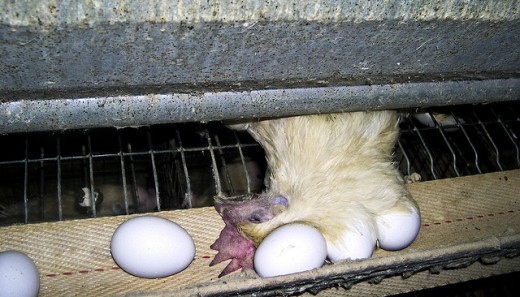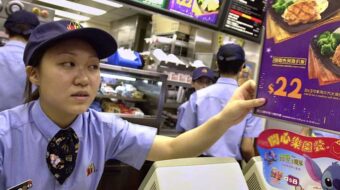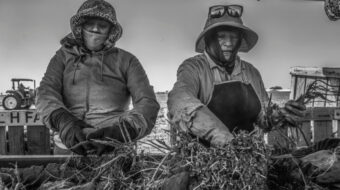
When I was a little boy, I remember following my grandmother out to the wooden chicken house on our family farm. There were eight or nine hens, softly clucking. We collected a few eggs every morning, stayed out of the way of the rooster, and I watched, surprised, when my tender, sweet grandmother slaughtered a hen from time to time.
In the early 1970s, I took a job at a brand new “industrial” hen house in Indiana. A friend of mine had told me about hen house construction and how I could work on the crew, building A-frame chicken cages and hooking up the snow-plow-like devices that would move the manure out of the giant manure pits. Everything was clean and spotless because there were no chickens there yet.
When the construction was done, I decided to stay on and help carry chickens upside down from the trucks and put them in their new homes. Chickens seem to become very quiet when you grab several of them and carry them upside down. But when they are jammed six to a cage, 20,000 to a house, 60,000 to the complex, their combined soft cluckings sound like a roar of a crowd after a touchdown at a football game.
One of my fellow workers loved to walk into the chicken house first thing in the morning and yell drill sergeant style, “Chickens!” For a moment, 20,000 chickens would go completely silent, then pick up one by one until the dense roar was in the air again.
The chickens, I was told, were given something in their food to make them lay eggs faster. They acted strange, attacking each other, sitting in the corner of the cage, dying. And they died by the hundreds. One worker was hired per chicken house to haul out dead chickens, to be taken away by the rendering truck, which picked up a 50 gallon drum of dead chickens every day. These were chickens who were brought to the house in the prime of their life, by chicken standards.
At the end of the cycle, we carried the survivors upside down to the truck, where they were hauled to a plant to be made into chicken soup. I didn’t eat canned chicken soup for 20 years after that. I still don’t eat the brand name that used the chickens.
The water pipes kept the water dripping continuously into each cage, and their feed was there for them all the time, laced with whatever needed to be in it to make them lay eggs faster than their nature meant them to. The conveyor belt that carried the massive supply of eggs to the packing house ran continuously at a certain time of day. The egg cases had little pictures of chickens walking in chicken yards with the sun shining and chickens wandering free underneath trees and sky.
The pictures on the egg cartons looked a little bit like the backyard on our family farm in the 1950s, and I think that was just the point. The producers wanted us to think about something in our past when we broke the eggs in our pan and made our eggs scrambled or over-easy.
I did some maintenance work at the chicken house, and I guess I didn’t know what was happening to me as I did this work. The job I did was to replace chicken manure plow cables when they would break under the weight of the manure. The engineers had designed the cable to be a little too small to handle the great weight of the manure generated by 20,000 chickens per house. The manure pits in theory probably looked great but when we had to climb down into the pit with rain coats and leg-high rubber boots on to splice the cables with U-bolts, knee-deep in manure, it wasn’t quite so nice as I am sure the blue print looked to the engineer who designed it. Even when we had taken the boots off and the rain coats off, the smell saturated our clothing.
When we arrived at the local town bar for lunch, somebody would always call out, “Lord God, there comes the chicken crew!”
It seemed to me that there were enough bad things going on that maybe we could have used a union. My parish priest had sparked my interest in the United Farm Workers in the 1960s, and I contacted the UFW who were organizing boycott activities in the region and talked to them about our situation and what it would take for us to become part of the United Farm Workers. I talked to several of my fellow workers and the task of unionization seemed overwhelming. The United Farm Workers didn’t seem like it fit their organizing strategy, and my fellow workers thought being in a union was a pipe dream, and said “I won’t be here too long.” So I gave up.
The smell did more than saturate my clothing. After a period of time, I begin to notice that my face and forehead ached, and then they ached all the time. I had splitting headaches. I went to the dentist because I thought I had an infected tooth. He told my friends who were with me, “He does not have an infected tooth; he has a massive sinus infection and needs to go to the emergency room immediately.”
I passed out on the way to the hospital. I looked at my signature later when I was admitted to the hospital. It was barely “chicken scratch.” I was in the hospital for a week, shot full of the latest antibiotics of that time, having my sinuses drained with a great needle, and at the end of the stay, the doctor said to me, “Son, I have rarely seen a sinus infection so bad. If you had gotten it in the days before antibiotics, back in the day when I started practicing as a doctor, you would have died.”
I asked the doctor, “I worked in the big chicken houses– do you think that had something to do with it?”
“I don’t know,” he said. And that was the end of it. After having my sinuses drained one more time, I moved on with my life.
Safety issues and farmworkers’ rights, as brought out in the latest “egg scandal,” were there for everyone to see at the very beginning of the factory farms, if you were there. I was there. I saw it. I felt it, but the overwhelming majority of people did not see it, did not feel it.
The very positive work of the young activist in publicizing the terrible conditions at some factory farms makes a coalition ever more possible between farm workers, potential organic farmers, and the food-consuming public (meaning all of us).
We must support the United Farm Workers and the Farm Labor Organizing Committee in their efforts to become nationwide unions, representing farm workers everywhere while keeping their wonderful grassroots qualities as both movements and effective unions.
If you are not already interested in organic food as a consumer, start studying the interconnection between organic food production, worker and consumer health, environmental quality, and animal protection.
Even if you’re not a vegan or vegetarian, there is a possible alliance with animal rights’ activists and people who would like to eat organically grown, humanely produced meat, eggs, and milk.
If you are in some way connected to a family farm or the agricultural industry, fighting for national policies that emphasize organic production and humane production benefits us all.
Many farmworker rights activists, organic farmers, environmentalists, animal rights’ activists, and consumers interested in consumption of organic milk, meat, and eggs have a natural common interest together.
Photo: FarmSanctuary.org/CC

MOST POPULAR TODAY

High Court essentially bans demonstrations, freedom of assembly in Deep South

UN warns that Israel is still blocking humanitarian aid to Gaza

Resource wars rage in eastern Congo, but U.S. capitalism only sees investment opportunity

U.S. imperialism’s ‘ironclad’ support for Israel increases fascist danger at home







Comments